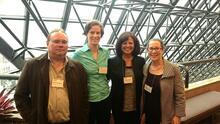In this paper we share a classroom implementation of a task about basis in linear algebra, which was originally developed for research about the topic. The task asks students to construct an everyday situation that captures the definition of basis, and then to critique it mathematically. Using this task, the original research study uncovered learning resources from a group of undergraduate women of color. A mathematician who was not involved in the original study was given the opportunity to work with a group of underrepresented minority students in a linear algebra course. She was inspired by the findings of the study and decided to implement the task independently in her course. She shares how she did it, how her students responded to the task, and how it helped her further develop her understanding of an anti-deficit perspective in teaching mathematics.
Publications
2019
2017
Most mathematics departments are not very diverse. Many mathematical sciences and mathematics education faculty would like this to change, but feel lost as to what they can do as individuals. This challenge motivated me to organize “Increasing Diversity and Inclusion in Mathematics: Some Inspiring Initiatives,” a minisymposium at the inaugural SIAM Conference on Applied Mathematics Education (ED16) last September.
2015
Absorbing layers are sometimes required to be impractically thick in order to offer an accurate approximation of an Absorbing Boundary Condition for the Helmholtz equation in a heterogeneous medium. It is always possible to reduce an absorbing layer to an operator at the boundary by layer stripping elimination of the exterior unknowns, but the linear algebra involved is costly. We propose to bypass the elimination procedure, and directly fit the surface-to-surface operator in compressed form from a few exterior Helmholtz solves with random Dirichlet data. The result is a concise description of the Absorbing Boundary Condition, with a complexity that grows slowly (often, logarithmically) in the frequency parameter.
Absorbing layers are sometimes required to be impractically thick in order to offer an accurate approximation of an Absorbing Boundary Condition for the Helmholtz equation in a heterogeneous medium. It is always possible to reduce an absorbing layer to an operator at the boundary by layer stripping elimination of the exterior unknowns, but the linear algebra involved is costly. We propose to bypass the elimination procedure, and directly fit the surface-to-surface operator in compressed form from a few exterior Helmholtz solves with random Dirichlet data. The result is a concise description of the Absorbing Boundary Condition, with a complexity that grows slowly (often, logarithmically) in the frequency parameter.
2014
Absorbing layers are sometimes required to be impractically thick in order to offer an accurate approximation of an absorbing boundary condition for the Helmholtz equation in a heterogeneous medium. It is always possible to reduce an absorbing layer to an operator at the boundary by layer-stripping elimination of the exterior unknowns, but the linear algebra involved is costly. We propose to bypass the elimination procedure, and directly fit the surface-to-surface operator in compressed form from a few exterior Helmholtz solves with random Dirichlet data. We obtain a concise description of the absorbing boundary condition, with a complexity that grows slowly (often, logarithmically) in the frequency parameter. We then obtain a fast (nearly linear in the dimension of the matrix) algorithm for the application of the absorbing boundary condition using partitioned low rank matrices. The result, modulo a precomputation, is a fast and memory-efficient compression scheme of an absorbing boundary condition for the Helmholtz equation.
2010
Article based on my high school senior thesis in a French language magazine aimed at engaging high school students and teachers to explore mathematics.
2007
Graphs with a strong expansion property are extremely useful in many areas of mathematics and computer science, particularly in the design of efficient algorithms. It is, however, very difficult to explicitly construct infinite families of good expanders. In this paper, we study the spectrum of biregular graphs and show how it is related to their expansion coefficient. We also describe a construction of biregular expanders from elliptic curves. Finally, we present some experimental results on the second largest eigenvalues of biregular graphs with degrees 2 and 7.
